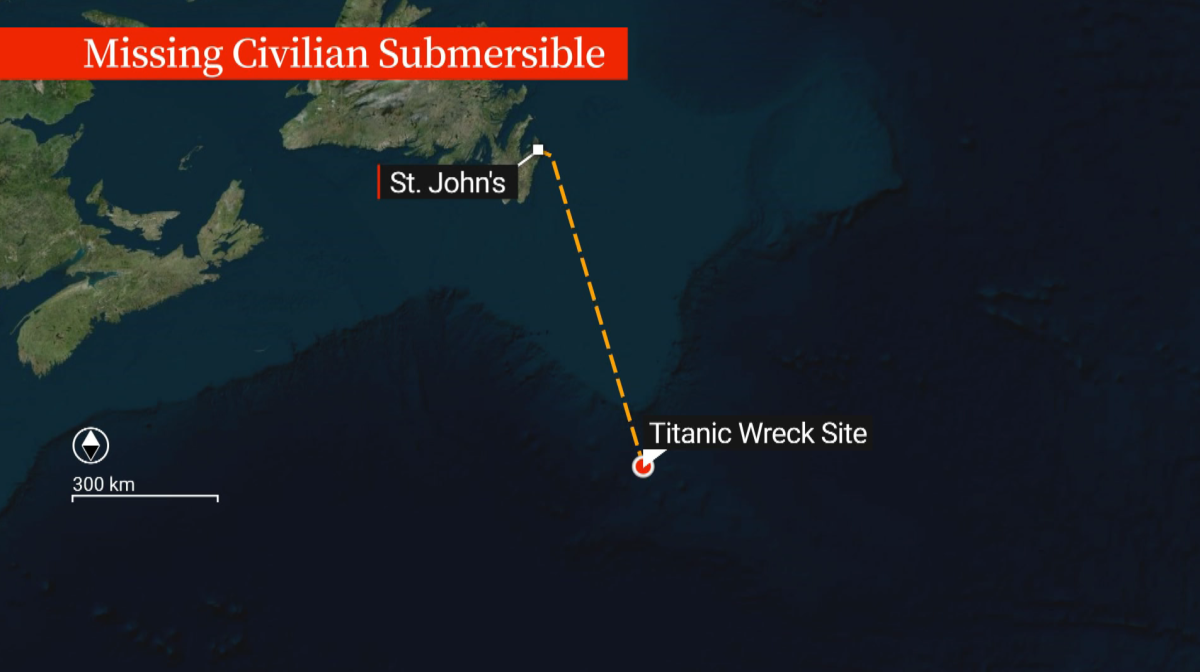An extensive search-and-rescue has entered its third day trying to locate a submersible that went missing during a dive to the Titanic shipwreck, and time is running out.

Rescuers have been racing against the clock because even under the best of circumstances, the vessel, OceanGate Expedition’s Titan, could run out of oxygen as soon as Thursday morning.
A glimmer of hope came Wednesday morning, when the U.S. Coast Guard (USCG) said in a statement that a Canadian aircraft had detected noises underwater.
The statement did not elaborate on what rescuers believe the noises could be. In underwater disasters, a crew unable to communicate with the surface relies on banging on their submersible’s hull to be detected by sonar. However, no official has publicly suggested that’s the case and noises underwater can come from a variety of sources.
While it’s too early to say what has happened to the Titan, experts have offered insight into some of the most likely scenarios.
A power failure
According to OceanGate’s website, the Titan has an acoustic link with its surface vessel, the Canadian icebreaker Polar Prince, which communicates using a transponder on its end and a transceiver on the receiving end. This link allows for underwater acoustic positioning, and for short text messages to be sent between the two vessels — usually basic status information.
Given that the Titan is a battery-operated submersible and has lost all contact with its surface vessel, it may have lost power. While these types of vessels typically have an emergency backup power source, it’s unclear if the Titan had an independent battery.

A power failure is considered the best-case scenario for the 20,000-pound Titan. Experts have said that if the submersible’s inbuilt safety system is operating properly, there’s a chance the vessel could drop additional weight and return to the water’s surface.
Some have said there’s a chance that the Titan has surfaced and is bobbing on top of the water already, and it’s just a matter of time until it’s spotted by rescue crews.
The bad news is if the passengers are stranded on top of the water, they remain out of luck until someone finds them; as CBS News journalist David Pogue told the BBC, passengers are sealed inside the vessel’s main capsule with no way of getting out.
He recalled from his close-up of the Titan last November that the passengers are sealed into the sub before they begin their expedition. Crews apply more than a dozen heavy bolts from the outside, which must be removed by an external crew in order to exit.
A tangled situation
There is also a chance that the Titan is snagged on something in the water — perhaps a piece of the shipwreck or a large fishing net.
The wreckage of the Titanic, which came to rest approximately four kilometres below the ocean’s surface, is a hazardous area with debris everywhere.
“There are parts of it all over the place. It’s dangerous,” said Frank Owen, a retired Royal Australian Navy official and submarine escape and rescue project director, in an interview with The Guardian.

Because the vessel lost contact at one hour and 45 minutes into its trip, the crew may have been close to or at the bottom of the ocean, Owen said.
A failure in pressure
The worst-case scenario is that there has been a leak or damage to the Titan’s pressure hull.
Ian Ballantyne, the editor of International Warships Fleet Review magazine, told the U.K.’s Express publication that “if they suffered a hull rupture the craft and its occupants will likely have swiftly met their end.
“If the craft has retained hull integrity along with air plus power to maintain life support systems, there may be a chance … though submarine rescue beyond the continental shelf is unheard of even in the military,” he continued.
“If it has gone down to the seabed and can’t get back up under its own power, options are very limited,” said Alistair Greig, a professor of marine engineering at University College London.
“While the submersible might still be intact, if it is beyond the continental shelf, there are very few vessels that can get that deep, and certainly not divers.”
Pogue said the vessel’s resurfacing capabilities would be irrelevant if the sub became trapped or sprang a leak.
“There’s no backup, there’s no escape pod,” he said. “It’s get to the surface or die.”
A complex operation, regardless
In any scenario, the operation to locate and retrieve the Titan is complicated and faces a large set of factors that make it a difficult operation.
Because crews do not know if the vessel has surfaced, they must scour both the ocean’s surface and depths, which are both massive in terms of the search area.

Chris Parry, a retired rear admiral with the British Royal Navy, told Sky News a seabed rescue was “a very difficult operation.”
“The actual nature of the seabed is very undulating. Titanic herself lies in a trench. There’s lots of debris around. So trying to differentiate with sonar in particular and trying to target the area you want to search in with another submersible is going to be very difficult indeed.”
The ocean’s temperature, weather and sea conditions and visibility above and below the water are also factors that can impact the search.
Aaron Newman, who has been a passenger on the Titan, told NBC’s Today that if the submersible is below a couple hundred metres and without power, the passengers are in complete darkness and it’s cold.
“It was cold when we were at the bottom,” he said. “You had layered up. You had wool hats on and were doing everything to stay warm at the bottom.”
David Gallo, a senior advisor for strategic initiatives at RMS Titanic, told CNN that dwindling oxygen levels and fighting the cold were the primary concerns for the passengers’ safety at this point.
“The water is very deep — two miles-plus,” Gallo said. “It’s like a visit to another planet. It’s not what people think it is. It is a sunless, cold environment and high pressure.”
In addition to an international array of ships and planes, an underwater robot has begun searching in the vicinity of the Titanic and there is a push to get salvage equipment to the scene in case the sub is found.
Lost aboard the vessel is pilot Stockton Rush, the CEO of the company leading the expedition. His passengers are a British adventurer, two members of a Pakistani business family and a Titanic expert.
— With files from Global News’ Aaron D’Andrea and The Associated Press











Comments